Complete Solutions to REVISION EXERCISES SHORT ANSWER QUESTIONS of chapter ORGANIC COMPOUNDS CONTAINING NITROGEN of Class 12 book with complete answers and questions
| Class 12 | CHEMISTRY |
| Chapter | ORGANIC COMPOUNDS CONTAINING NITROGEN |
| MODERN PUBLICATION | REVISION EXERCISES SHORT ANSWER QUESTIONS |
| Number Of Questions | 49 |
| Academic Year | 2023-24 |
Explain the following:
(i) Tertiary amines do not undergo acylation.
(ii) `CH_(3)NH_(2)` is stronger base than ammonia.
(iii) It is difficult to prepare pure amines by ammonolysis of alkyl halides.
View SolutionAn amine (A) `C_(3)H_(9)N` reacts with nitrous acid at 0 to `5^(@)C` to give an oily layer separated from reaction mixture. Write the structure of A and its reaction with
(i) acetyl chloride
(ii) methyl magnesium bromide.
View Solution(a) Why have primary amines higher boiling point than tertiary amines?
(b) How can you find out whether a given amine is a primary amine? Write the chemical reaction involved in the test you perform.
View SolutionIn the following cases rearrange the compounds as directed:
(i) In an increasing order of basic strength:
`C_(6)H_(5)NH_(2), C_(6)H_(5)N(CH_(3))_(2), (C_(2)H_(5))_(2)NH` and `CH_(3)NH_(2)`
(ii) In a decreasing order of basic strength:
Aniline, p-nitroaniline and p-toluidine
(iii) In an increasing order of `pK_(b)` values:
`C_(2)H_(5)NH_(2), C_(6)H_(5)NHCH_(3), (C_(2)H_(5))_(2)NH and C_(6)H_(5)NH_(2)`
View SolutionComplete the following chemical equations
(i)` C_(6)H_(5)N_(2)Cl+C_(6)H_(5)NH_(2)rightarrow`
(ii)`C_(6)H_(5)N_(2)+CH_(3)CH_(2)OHrightarrow`
(iii) `RNH_(2)+CHCl_(3)KOHrightarrow`
View Solution(a) Explain why an alkylamine is more basic than ammonia?
(b) How would you convert:
(i) Aniline to nitrobenzene
(ii) Aniline to iodobenzene
View Solution(a) Complete the following reaction:

(b) Explain ethylamine is more basic than ammonia.
(c) What is carbylamine reaction?
View Solution(a) Write chemical test, to distinguish between `CH_(3)NH_(2)` and `(CH_(3))_(2)` NH.
(b) Fill in the blanks :
(i) `CH_(3)CH_(2)I overset(NaCN)(to) ? underset("hydrolysis")overset(OH^(-), "partial")(to) ?`
(ii) `C_(6)H_(5)N_(2)Cl overset(CuCN)(to) ? underset(H^(+))overset(H_(2)O)(to) ?`
View SolutionWrite chemical equations for the following conversions:
(i) Nitrobenzene to benzoic acid
(ii) Benzyl chloride to 2-phenyl ethanamine
(iii) Aniline to benzoic acid.
View Solution(a) (i) Convert aniline to fluorobenzene.
(ii) Write structural formula of the compounds A to D:

(b) Write structural formulae of the compound A and B:
`C_(6)H_(5)CONH_(2) overset(Br_(2) // KOH)(to) A overset(Br_(2) // H_(2)O)(to) B`.
View Solution(a) Complete the following reactions:
(i) `C_(6)H_(5)NH_(2) + CHCl_(3) + KOH (alc.) overset(warm)(to)`
(ii) `C_(6)H_(5)N_(2)""^(-)Cl^(-)` `overset(Cu_(2)Cl_(2), HCl)(to)`
(b) Write coupling reaction.
View Solution(a) Complete the following reaction:
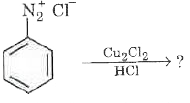
(b) Convert aniline into benzoic acid.
(c) What is Balz-Schiemann reaction?
View SolutionHow will you achieve the synthesis of only 4-bromoaniline from aniline without the production of the trisubstituted aniline.
View Solution(a) Why have primary amines higher boiling points than tertiary amines?
(b) Write the products obtained in the nitration of aniline.
(c) What is carbylamine reaction?
View SolutionGive one chemical test to distinguish between the following pairs of compounds:
(i) Methylamine and dimethylamine
(ii) Aniline and benzylamine
View SolutionAccount for the following:
(i) `pK_(b)` of aniline is more than that of methylamine.
(ii) Ethylamine is soluble in water whereas aniline is not.
(iii) Methylamine in water reacts with ferric chloride to precipitate hydrated feric oxide.
(iv) Although amino group is o– and p– directing in aromatic electrophilic substitution reactions, aniline on nitration gives a substantial amount of m-nitroaniline.
(v) Aniline does not undergo Friedel-Crafts reaction.
Diazonium salts of aromatic amines are more stable than those of aliphatic amines.
(vii) Gabriel phthalimide synthesis is preferred for synthesising primary amines.
View SolutionGive the structures of A, B and C in the following reactions:
(i) `C_(6)H_(5)N_(2)""^(+)Cl^(-) overset(CuCN)(to) A overset(H_(2)O // H^(+))(to) B underset(Delta)overset(NH_(3))(to) C`
(ii) `C_(6)H_(5)NO_(2) overset(Sn,HCl)(to) A overset(NaNO_(2),HCl)(to) B underset(Delta)overset(H_(2)O // H^(+))(to) C`
View SolutionWrite Hinsberg's test to distinguish primary, secondary and tertiary amines.
View SolutionWrite short notes on the following:
(i) Carbylamine reaction
(ii) Gabriel phthalimide reaction.
(iii) Hoffmann bromamide reaction.
(iv) Gattermann reaction.
(v) Balz Schiemann reaction.
(vi) Coupling reaction.
View SolutionHow will you canvert the following :
(i) Nitrobenzene into aniline,
(ii) Ethanoic acid into methanmine
(iii) Aniline into N-phenylethanaminde (write the chemical equations involved).
View SolutionGive the structures of A, B and C in the following reactions:
(i) `CH_(3)Br overset(KCN)(to) A overset(LiAlH_(4)(to) B underset(273 K)overset(HNO_(2))(to) C`
(ii) `CH_(3)COOH underset(Delta)overset(NH_(3))(to) A overset(Br_(2)+KOH)(to) B overset(CHCl_(3) + NaOH)(to) C`
View Solution(a) What is Hoffmann's bromamide reaction? Write the reaction involved in it.
(b) Secondary amine is stronger base than tertiary amine.
Give reason.
(c) Complete the following reactions:

(ii) `C_(2)H_(5)NH_(2) + CH_(3)COCI to`
View Solution(a) Give one reaction that can be used as a test for primary amines.
(b) Arrange the following substances in increasing order of their basic strength in water:
`C_(6)H_(5)NH_(2),(C_(2)H_(5)) _(2)NH, (C_(2)H_(5)) _(3)N, C_(2)H_(5)NH_(2)`
(c) Out of ethylamine and ethyl alcohol, which has higher boiling point and why?
View Solution(a) Why is the secondary amine more basic than primary amine?
(b) Explain Hoffman mustard oil reaction.
(c) How is a primary amine distinguished from a secondary amine using a chemical test?
View Solution(a) Account for the correct order of decreasing basicity of ethylamine, 2-aminoethanol and 3-aminopropan-1-ol
(b) How will you convert aniline into chlorobenzene?
(c) Write a short note on carbylamine test.
View Solution(a) Write coupling reaction.
(b) Give a chemical test to distinguish between aniline and N-methylaniline.
(c) How will you convert benzoic acid to aniline?
View Solution(a) What is Garbriel phthalimide reaction? Give the reaction.
(b) Complete the following reactions:
(i) `CH_(3)CONH_(2) + Br_(2) + 4KOH to` ? + ? + ? + ?
(ii) `CH_(3)CH_(2)NH_(2) + HNO_(2) overset(lt 5^(@)C)(to)` ? + ? + ?
View SolutionCARBYLAMINE REACTION
View Solution(a) Why is secondary amine more basic than the tertiary amine?
(b) How can `1^(@), 2^(@)` and `3^(@)` amine be distinguished by Hinsberg test?
(c) Complete the reaction:
(i) `CH_(3)CONH_(2) + 4[H] overset(LiAlH_(4) // ether)(to)` ?

View Solution(a) Write the chemical equations of:
(i) Coupling reaction
(ii) Mendius reaction
(b) Why amines have higher boiling points than corresponding hydrocarbons.
View SolutionIdentify A, B, C and D in the following conversions:
`A underset(273-278 K)overset(NaNO_(2) // HCl)(to) CH_(3)OH overset(PCl_(3))(to) B overset(KCN)(to) C overset(LiAlH_(4))(to) D`
View SolutionWrite the structures of A, B and C in the following:
(i) `C_(6)H_(5)CONH_(2) overset(Br_(2) // aq. KOH)(to) A underset(0-5^(@)C)overset(NaNO_(2) // HCl)(to) B overset(KI)(to) C`
(ii) `CH_(3)Cl overset(KCN)(to) A overset(LiAlH_(4))(to) B underset(Delta)overset(CHCl_(3) + alc KOH)(to) C`
View Solution(a) What happens when aniline reacts with bromine water at room temperature?
(b) Give a chemical test for primary amines.
(c) Write the diazotisation reaction of aniline.
View Solution(a) Classify the following amines as primary, secondary and tertiary.
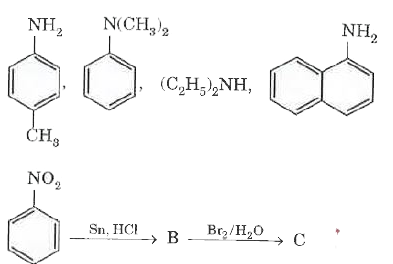
Identify the products B and C and write their formulae.
View SolutionIdentify the compounds X, Y and Z in the following reactions:

View Solution(a) Explain, with the help of chemical equations, how the following compounds would be obtained from benzene diazonium chloride:
(i) Iodobenzene
(ii) 4-Aminoazobenzene
(b) Complete the following reaction:
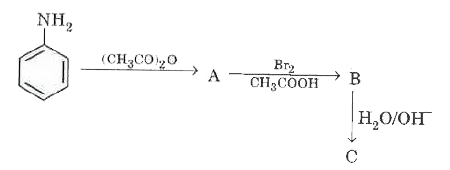
(c) What will happen if aniline is treated with aqueous bromine?
View Solution(a) Name the test used to identify primary amines using `CHCl_(2)` and ethanolic KOH.
(b) How can you convert methyl iodide to ethanamine?
View SolutionWrite the structures of main products when benzene diazonium chloride reacts with the following reagents:
(i) CuCN
(ii) `CH_(3)CH_(2)OH`
(iii) KI
View SolutionWrite equations of the following reactions:
(i) Acetylation of aniline
(ii) Coupling reaction
(iii) Carbylamine reaction
View Solution(a) Arrange the following compounds in an increasing order of basic strengths in their aqueous solutions:
`NH_(3), CH_(3)NH_(2), (CH_(3)) _(2)NH, (CH_(3)) _(3)N`.
(b) Complete the following reaction equations:
(i) `RCONH_(2) underset(H_(2)O)overset(LAH)(to)`
(ii) `C_(6)H_(5)N_(2)Cl + H_(3)PO_(2) + H_(2)O to`
(iii) `C_(6)H_(5)NH_(2) + Br_(2) (aq) to`
View SolutionGive the chemical tests to distinguish between the following pairs of compounds :
(i) Ethylamine and Aniline
(ii) Aniline and Benzlamine
View SolutionGiven the chemical tests to distinguish between the following pairs of compounds :
(i) Methylamine and Dimethylamine
(ii) Aniline and N - Methylamine
View SolutionGive the structures of the products A, B and C in the following reactions:
(i) `CH_(3)CH_(2)Br overset(KCN)(to) A overset(LiAlH_(4))(to) B underset(0^(@)C)overset(HNO_(2))(to) C`
(ii) `CH_(3)COOH underset(Delta)overset(NH_(3))(to) A overset(NaOH + Br_(2))(to) B overset(CHCl_(3) + alc KOH)(to) C`
View SolutionComplete the following reactions :
(i) `CH_(3)CH_(2)NH_(2) + CHCl_(2) + alc. KOH to`
(ii) `C_(6)H_(5)N_(2)"" ^(+)Cl^(-) underset("(Room Temp.)")overset(H_(2)O)(to) `

View SolutionWrite the main products of the following reactions :
(i) `C_(6)H_(5)N_(2)""^(+)Cl^(-) overset(H_(3)PO_(2) + H_(2)O)(to)` ?
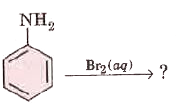
(iii) `CH_(3)-underset(O)underset(||)(C)-NH_(2) overset(Br_(2) + NaOH)(to)` ?
View SolutionWrite the main products of the following reactions:
(i) `CH_(3)CH_(2)NH_(2) underset(0^(@)C)overset(HNO_(2))(to)` ?
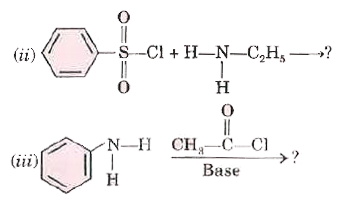
View SolutionWrite the structures of A, B and C in the following:
(i) `C_(6)H_(5)COO^(-)NH_(4)^(+) overset(Delta)(to) A overset(Br_(2) // KOH)(to) B underset("pyridine")overset(CH_(3)COCl)(to) C`
(ii) `C_(6)H_(5)N^(+)BF_(4)^(-) underset(453-473 K)overset("Heat")(to) A overset(Sn//HCl)(to) B underset(Delta)overset(CHCl_(3) + alc. KOH)(to) C`
View SolutionGive reasons for the following
(a) Acetylation of aniline reduces its activation effect.
(b) `CH_(3)NH_(2)` is more basiic than `C_(6)H_(5)NH_(2)`.
(c) Although `-NH_(2)` is o/p directing group, yet aniline on nitration gives a significant amount of m-nitroaniline.
View SolutionWrite the structures of compounds A, B and Cin the following reactions:
(a) `CH_(3) - COOH overset(NH_(3) // Delta)(to) A overset(Br_(2) // KOH(aq))(to) B overset(CHCl_(3) + alc. KOH)(to) C`
(b) `C_(6)H_(5)N_(2)^(+)BF_(4)^(-) underset(Delta)overset(NaNO_(2) // Cu)(to) A overset(Fe // HCl)(to) B overset(CH_(3)COCl // "pyridine")(to) C`
View Solution
REVISION EXERCISES SHORT ANSWER QUESTIONS questions and complete solutions for chapter ORGANIC COMPOUNDS CONTAINING NITROGEN of MODERN PUBLISHERS CHEMISTRY (HINGLISH) of Class 12
All Exercises from MODERN PUBLICATION Class 12 CHEMISTRY ORGANIC COMPOUNDS CONTAINING NITROGEN
- Competition File (B) MULTIPLE CHOICE QUESTIONS
- Competition File (C) MULTIPLE CHOICE QUESTIONS
- Competition File (D) MULTIPLE CHOICE QUESTIONS (based on the given passage/comprehension )
- Competition File Integer Type or Numerical Value Type Questions
- Competition File Matrix Match Type Questions
- Competition File (OBJECTIVE TYPE QUESTIONS) (MULTIPLE CHOICE QUESTIONS (M.C.Q)) (A)
- CONCEPTUAL QUESTIONS
- HIGHER ORDER THINKING SKILLS (ADVANCED LEVEL)
- NCERT FILE ASSERTION AND REASON TYPE QUESTIONS
- NCERT FILE MATCHING TYPE QUESTIONS
- NCERT FILE MULTIPLE CHOICE QUESTION (TYPE -II)
- NCERT FILE NCERT (EXEMPLAR PROBLEMS) (MULTIPLE CHOICE QUESTION (TYPE -I))
- NCERT FILE NCERT (TEXTBOOK EXERCISES)
- NCERT FILE SHORT ANSWER TYPE QUESTIONS
- NCERT FILE (NCERT IN-TEXT QUESTIONS)
- PRACTICE PROBLEMS
- QUICK MEMORY TEST B. COMPLETE THE MISSING LINKS
- QUICK MEMORY TEST C. CHOOSE THE CORRECT ALTERNATIVE
- QUICK MEMORY TEST A. SAY TRUE OR FALSE
- REVISION EXERCISES ASSERTION REASON QUESTIONS
- REVISION EXERCISES LONG ANSWER QUESTIONS
- REVISION EXERCISES PASSAGE BASED QUESTIONS
- REVISION EXERCISES SHORT ANSWER QUESTIONS
- REVISION EXERCISES VERY SHORT ANSWER QUESTIONS
- REVISION EXERCISES (OBJECTIVE TYPE QUESTIONS) (MULTIPLE CHOICE QUESTIONS)
- SOLVED EXAMPLE
- UNIT PRACTICE TEST